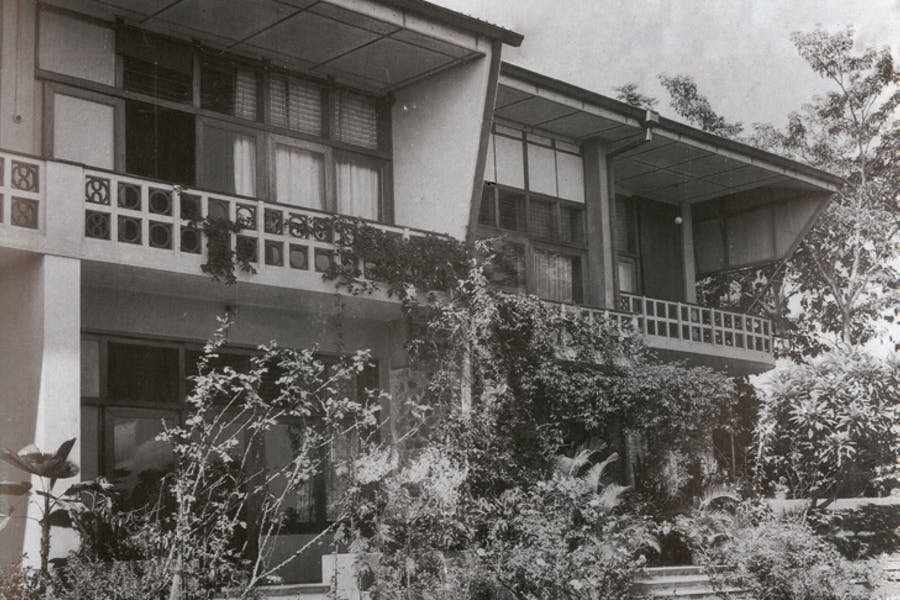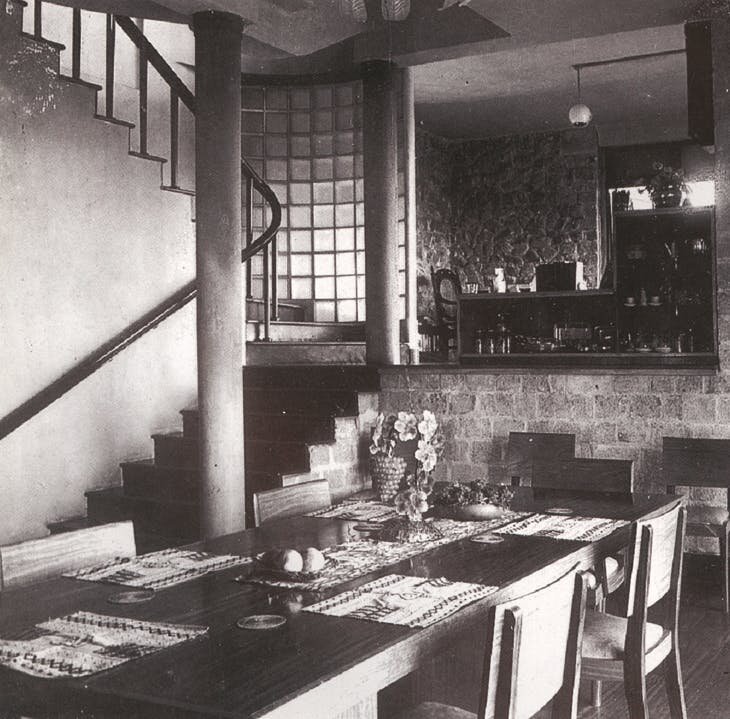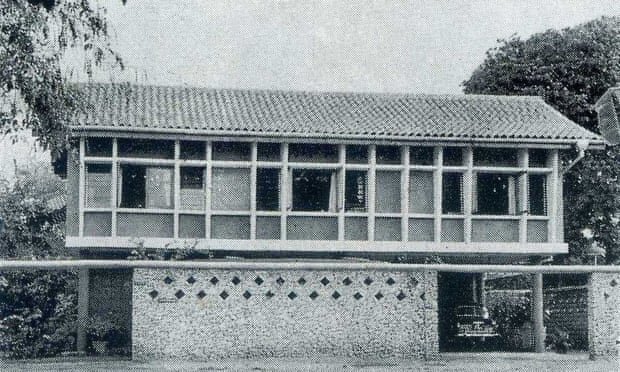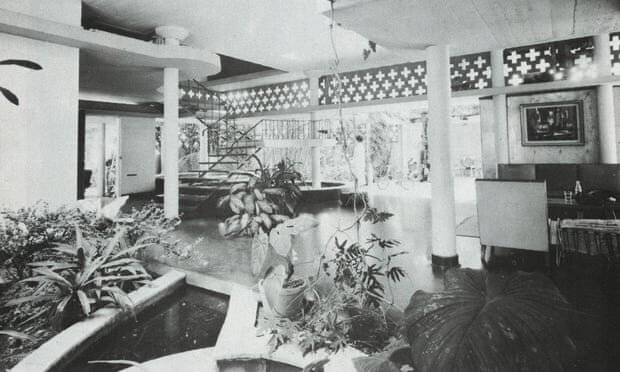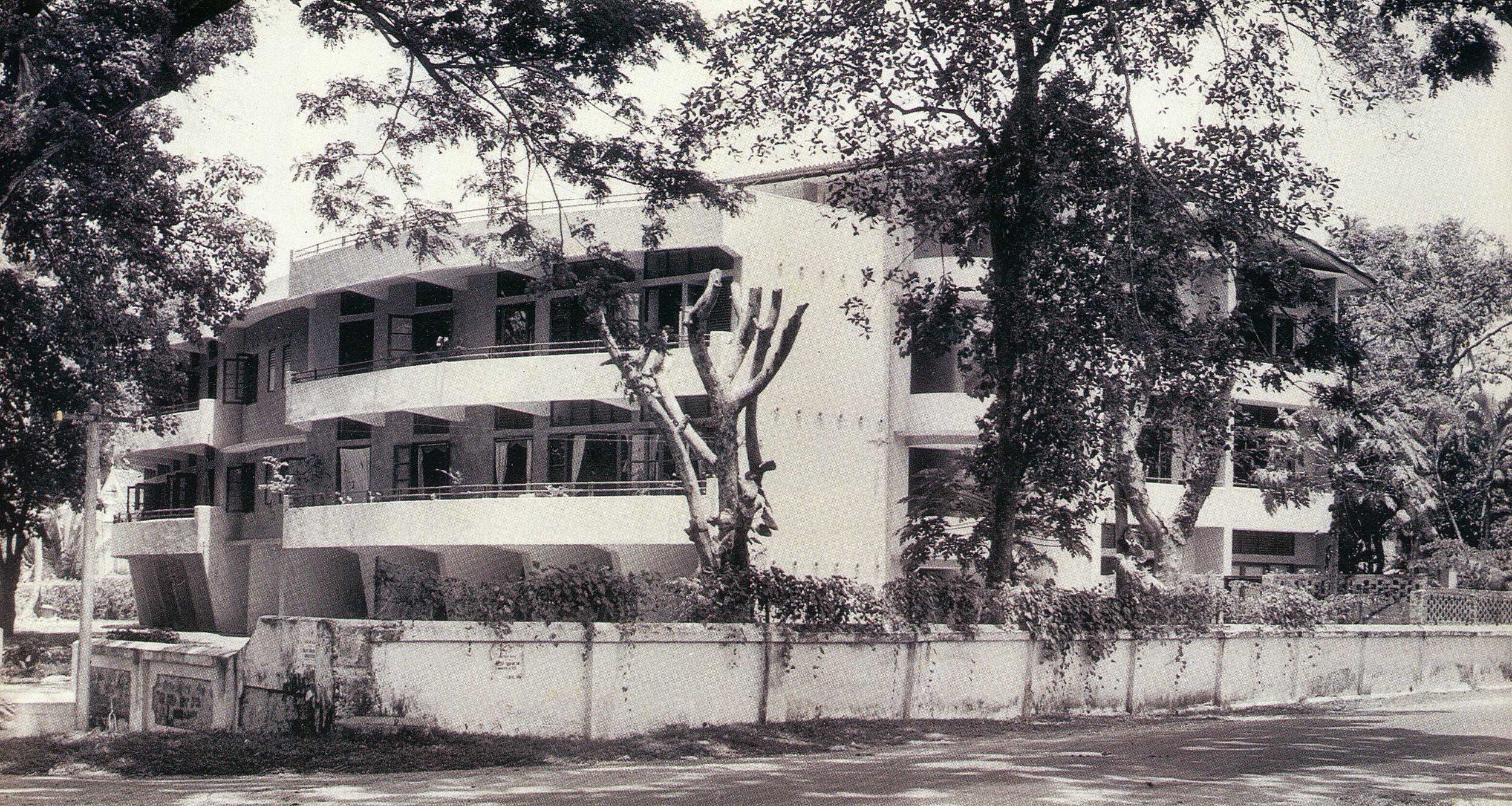Episode 17: Minnette de Silva
Minnette de Silva was born February 1st, 1918, in Kandy, Ceylon, today Sri Lanka. She studied architecture in Bombay and worked as an apprentice for the firm, Mistri, and Bhedwar. During this time her sister was also in Bombay and she along with a group of people founded Marg, a quarterly journal on modern art and culture. Minnette was a contributing editor. After Bombay, she graduated in 1948 from the AA in London. She was the first South Asian woman to become an Associate Member of the Royal Institute of British Architects. She attended CIAM as a delegate of Sri Lanka and India making her the first Asian delegate of the group. There Minnette became close friends with Jane Drew and Le Corbusier. After she graduated she returned to Sri Lanka.
She was one of the first architects in Sri Lanka that incorporated what she learned from the West with Indian and Sri Lankan architecture. Her work includes the Pieris House, the Amarasinghe Residence, the Fernando House, Aluwihare Sports Pavilion Police Park. During the 1970s she wrote the section on South Asian Architecture in the 18th edition of Banister Fletcher’s A History of Architecture. After that, she joined the Department of Architecture at the University of Hong Kong, as a History of Asian Architecture lecturer. In 1996, she was awarded the Gold Medal by the Sri Lanka Institute of Architects. Minnette dreamed of publishing an autobiography yet on November 24, 1998, she died at 80 years old. The incomplete autobiography was published posthumously in 1998. It's called "The Life and Work of an Asian Woman Architect."
Publications
Marg Journal, Contributing editor, 1946
18th edition of Banister Fletcher’s A History of Architecture, Section on South Asian Architecture, 1975
The Life and Work of an Asian Woman Architect, 1998
Caryatid: Assumpta Nnaggenda-Musana
Assumpta is an architect, urban planner and academic from Uganda. She is a lecturer in the Department of Architecture and Physical Planning, in the College of Engineering, Design, Art and Technology, at Makerere University, in Uganda. She was the first Ugandan woman to achieve a doctorate degree in architecture. Her research focused on informal settlements of Uganda and Kenya. She specializes in sustainable urban settlements and low-income housing schemes in developing countries. Through her work Assumpta values integrating vernacular architecture with the architectural principles from abroad.
-
This transcript was prepared during the development of the episode.
Final recorded episode may deviate slightly from the content presented below as changes, edits, or improvements may be made during the recording and editing process.
Disclaimer: some words are written phonetically throughout episode
Norgerie: Ayubowan, welcome to She Builds Podcast, where we share stories about women in the design and construction field, one lady at a time. Today we’re gonna talk about Minnette de Silva, a pioneering figure of architecture in Sri Lanka. I’m Norgerie Rivas reading about genetically engineered mosquitoes that will be released in my county in Houston Texas.
Jessica: Hi, I’m Jessica Rogers freaked out about those engineered mosquitoes in Washington DC
Lizi: Hi, I’m Lizi Raar, not worrying about mosquitos in San Francisco.
Jessica: Like always our quick disclaimer. The three of us are not historians, nor are we experts on this subject. We are just sharing stories about the information that we find about each woman. If we get our facts a little mixed up, please forgive us, leave us a comment and we will all continue learning.
Norgerie: Today I’m gonna take you on a journey east, all the way to the island of Sri Lanka. You know I love islands.
Lizi: You sure do.
Jessica: Puerto Rico is a beautiful island
Norgerie: The time was February 1st 1918, the place, Kandy, Ceylon. Today the island is no longer called Ceylon, its Sri Lanka.
Jessica: ( Saylawn) Ceylon was the name when they were a British colony but they achieved independence and got a name change, rebranded, you know.
Norgerie: Yes, and this was very important because like you said when she was born the island was a British colony. Her dad, George De Silva was a known journalist, lawyer, and politician. In his lifetime he was President of the Ceylon National Congress, and also served as a Minister of Health. Her mom Agnes Nell was an activist who pioneered women related issues in her country such as suffrage. And in her free time she designed their family home.
Lizi: Fun!
Norgerie: Yeah, you know. Both of Minnette’s parents worked towards Sri Lankan independence from British rule and progressive causes, such as women’s rights. And they were shakers and bakers, important figures like Gandhi and Indian Prime Minister Nehru visited and stayed in Minnette’s family home. There is a story that one time a house guest complained about the beds and Minnette said well if they are good enough for Ghandi they are good enough for you.
Jessica: BAM
Lizi: oh okay Minette. She’s got some sass. I approve. Also... casual Gandhi name drop.
Norgerie: Minnette was the baby of the family, she and I have that in common, young Minnette became friends with young Indira Gandhi who was Nehru’s daughter, they were about the same age. Later in life Indira became Prime Minister of India and to this day she is the only female Prime Minister India has ever had.
Lizi: Minette was hanging with some big players.
Jessica: ooh that’s pretty cool
Norgerie: Minnette’s sister Anil de Silva was an art critic, political activist, and historian, and her brother Fredrick de Silva was a lawyer and politician who served as Mayor of Kandy, a member of Parliament, and Sri Lanka's Ambassador to France. Frederick married Esme Nathaniels who had spent a year at the Bauhaus.
Lizi: This family is like success on success on success.
Jessica: Yeah a family of high achievers
Norgerie: When Minnette was a child she was educated at St. Mary's, in Brighton (Brigh-ton), England, and returned to Ceylon when she was eleven. Then in 1939 at the age of 21 Minnette announced to her family that she wanted to be an architect and they were like absolutely not.
Lizi: uhhh Why not!??
Jessica: Yeah what’s wrong with becoming an architect????
Norgerie: Who knows… It was this whole thing. But eventually she convinced her father to let her do it. Her father, the guy that was progressive, thought architecture was a little too progressive for a lady. Ladies, her aunt was a doctor. Her mother and older sister were political activists, her sister in law was a designer, yet architecture is just crossing a line, I don't get it, what makes architecture so scandalous?
Lizi: I feel like we’ve come across this a lot when studying these women, that people seemed to feel that women doctors and lawyers were necessary and they could understand why having women in those professions was important, but that apparently didn’t apply to STEM industry professions, which is so bizarre. I think it was Louise Bethune who had a quote saying exactly that. I mean she obviously supported women in the architecture profession, but she had that whole argument that the female gender didn’t change how a person approaches a design project, and differentiated it from doctors and lawyers. And Concepcion from a few weeks ago, when she was certified, the article talked about how there were already women doctors and lawyers, but women hadn’t broken into engineering thus far.
Jessica: We can also say that Mariana who talked about landscape architecture… she didn’t think it was a profession for women…. Remember? H Y P O C R I T E
Norgerie: Well, she went to study in Bombay and there she worked as an apprentice for the firm, Mistri and Bhedwar and she became friends with Perin Mistri and her brother Minoo. Actually, Perin Mistri was an Indian architect and one of the first women to qualify as an architect in India.
Jessica: Future episode alert *AIRHORNS
Norgerie: Minnette also took private classes at the Architectural Academy and then some sources say she enrolled in the Sir J J School of Art, but others say that she didn't. Regardless of which school she went to, she was part of political and cultural circles, she rubbed elbows with Mulk Raj Anand the writer of, today classic, then modern Indio English literature, and she was also buddies with Ravi Shankar, famous Indian musician and composer. During this time her sister was also in Bombay and she along with a group of people including Mulk Raj Anand, founded Marg, a quarterly journal on modern art and culture. Minnette was a contributing editor.
Lizi: Cooooool
Jessica: OHHHH
Norgerie: She was all work work work (Rhianna). In her spare time which only Minnette knows when that was, she went to a Free Ghandi March and she got expelled from school.
Lizi: Oh dang. I guess she grew up with a bunch of activists, but does that warrant expulsion?
Jessica: Yeha was this too rebellious?
Norgerie: I don’t exactly know why, sources say it was for not writing an apology to the head of the school. But why would she need to apologize for that? Did she miss class? I dunno.
Lizi: WHAT!? She got expelled for not apologizing?
Norgerie: Yeah, weird. But that didn’t stop Minnette, she just went to work for the architect and planner Otto Koonigsbairger in his office in Bangalore, working on prefabricated housing for the Tata Steel City plan in Bihar.
Lizi: Look at Minette, didn’t give a crap about being expelled, she just kept on keeping on.
Jessica: yep
Norgerie: During that time she met the head of the Education Committee in the UK and he helped get her a spot to take an exam to enter the Architectural Association.
Jessica: Oh the AA in London the famous alma mater of Zaha Hadid, Denise Scott Brown, and Jane Drew from episode 7, just to name a few.
Lizi:Yeah, no big deal. Minnete working her connections! So, she got in right?
Norgerie: Of course she did, she showed that test who’s boss and she graduated in 1948. Actually she was the first south Asian woman to become an Associate Member of the Royal Institute of British Architects.
Jessica: Wait a minute when did Jane graduate again?
Norgerie: 1934
Jessica: So did they cross paths? maybe?
Norgerie: But you’re onto something because during her time in London, Minnette met and became lifelong friends with Jane Drew and Maxwell
Jessica: awwww DAME Jane and Maxi
Lizi: That’s so cool!!! They were biffles.
Norgerie: And do you remember that Jane and Max were part of CIAM.
Jessica: Yeah we do! Quick refresher for the listeners, CIAM were a group of international modern architects, it was revolutionary at the time and famous today. Was Minnette a part of CIAM too?
Norgerie: Yes, she went as a delegate of Sri Lanka and India. She was the very first Asian delegate of CIAM and she became close friends with a guy we’ve talked about before.
Jessica: Not Corbi Corb?
Norgerie: The one and only, famous starchitect Le Corbusier.
Lizi: Corbu gets around no?
Norgerie: She and Corb met up with each other and corresponded regularly until he died. There is some gossip that they were romantic but there’s no proof. I think Minnette was too smart to get involved with a married man 30 years her senior, I think they were just friends, maybe they flirted sometimes...
Jessica: Well, we all know that Corbu and some of these other starchitects liked to dip their toes where they didn't belong…. And who knows …. Long nights in the studio, coffee trips, site visits …. something could have happened with Minnette and Corbu
Lizi: Let’s hope not though, I feel like I’ve heard that Corbu got around.
Norgerie: Besides Minnette was very used to running in the same circles as famous artists her list of known accomplices included all the names I’ve been dropping, plus Pablo Picasso, Henri Cartier-Bresson, Aldous Huxley, and Laurence Olivier.
Lizi: Casual
Jessica: Wow
Norgerie: In fact, she never married, and supposedly one time she told a friend that husbands were only good for carrying one’s bags, whatever that means.
Lizi: And Minette can carry her own bags.
Jessica: they can carry the heavy things and open jars too.
Norgerie: In 1948 she spoke at the World Congress of Intellectuals in Defense of Peace, and you can see a little montage of this on YouTube I am gonna post the link in the show notes, you have to see it, it looks like they gave her a standing ovation, looks epic.
Lizi: Oh wow.
Jessica: ooh I wanna see
Norgerie: After she graduated her family insisted that she had to go back home, to the recently independent Sri Lanka and make her contributions, help the new country.
Jessica: oohh so now they see her value as an architect??!!
Norgerie: Right, go figure. Back home in Kandy, Sri Lanka, she was inspired by the architect Ananda Coomaraswamy (Coo-ma-ras-wa-my), who advocated for the preservation of the traditional arts and crafts, local craftsmen and the building methods and materials. That was super important to Minnette and it influenced her architectural style. She was also influenced by the modern architecture that was becoming popular at the time, and she also had education and perspectives from different countries. She was one of the first architects in Sri Lanka that incorporated what she learnt from the West with Indian and Sri Lankan architecture. She didn't do just one or the other or a weird mix. She was very careful of creating architecture that made sense in Sri Lanka. Her style is part of what is known today as tropical regionalism.
Lizi: That’s so interesting, and nice that she took what she learned, but didn’t try to plop it into a totally different culture and climate.
Jessica: Oh cool, it's interesting to think of recreating an aesthetic for essentially a new country?
Norgerie:Yes and think about it, the country had just achieved independence, so moving forward their cultural identity through architecture was extremely important. They had to form something that was their own, and not just a veneer of colonialism or complete foreign.
Lizi: That totally makes sense. So cool that she got to be part of it!
Jessica: DOPE
Norgerie: She spoke about her desire to create relationships between modern and traditional and I loosely quote because I only found this quote in spanish so I am forced to translate the translation but I’ll give it my quote voice anyway: “The necessities of our community and society need to find a regional expression in urban planning, housing, and public buildings. What happens often is that we copy closed occidental models that do not fit our region or we try adapt it to regional architecture in ways that do not fit.”
Jessica: this is awesome, An issue that we have talked about as we researched these international ladies was that we wanted to find women from these international cities that created authentic designs that catered to their respective countries. This is great Norgerie, like she focused her designs to reflect the culture of her country. Norgerie what are some other examples of her work?
Norgerie: Her first building was the Karu-narat-ne House in Kandy from 1949 to 1951, commissioned by friends of her parents. She designed a split level house for a site on a hill. It was considered an experiment of regional modern architecture, using modern materials like reinforced concrete, glass blocks, modern ideas of the open plan, movable walls, interior gardens, as well as local materials such as ceramics and teak wood. This building was the first of its kind. It was also the first building designed by a woman in Sri Lanka.
Lizi: Yeahhhhh
Jessica: woah on woah!!
Norgerie: The project was published in Marg Magazine and highly praised. So you’d think she was a celebrity with her innovative architecture, but by now we know better. She was the only woman architect in Sri Lanka and as you can imagine that caused her a lot of problems.
Lizi: Unwanted advances?
Norgerie: Well Lizi, articles mention how she was a very pretty woman and men used to follow her around so I would not be surprised if there were unwanted advances in her life.
Jessica: did she wear pants?? Was that the problem? Was she getting paid the same as the men?
Norgerie: HA! Good question in a lot of pictures I saw of her she was wearing dresses maybe that was the real issue. She definitely was not getting paid the same as men. She was a woman, she worked on her own, had her own firm. Contractors, the government and clients, all men, didn’t trust her because she was new and because she was a woman. I quote from Minnette “I was dismissed because I am a woman. I was never taken seriously for my work.” Because she did her job and stood her ground people started calling her a difficult woman.
Lizi: GRUNT
Jessica: hmmm the earlier version of “nasty woman”
Norgerie: Minnette paid no mind to the haters she kept doing her thing. She did a lot of work in the decade of the 50s such as the Pieris House in 1952, the Amarasinghe Residence and Fernando House in 1954, Aluwihare Sports Pavilion Police Park, 1955, and the Coomaraswamy Homes in 1960, I guess the last one is not part of the 50s but let's throw it in there.
Lizi: nice
Jessica: cool cool
Norgerie: As part of Minnette’s approach to design first, she talked for a long time with future householders, basically she surveyed how they lived. And then used this research to inform her designs.
Jessica: this reminds me of a few women that we have mentioned before…. I’m thinking a little bit like a caryatid from season one Elizabeth Roberts and even like Julia Morgan “the people’s architect”.
Lizi: Yes, and I also thought about Han Schroeder from earlier this season and how she would design adaptable spaces for people based on the needs they had to make a space more efficient.
Norgerie: Actually the Fernando House that I mentioned before, the original owner was still living there at least in 2018 and she talked about how Minnette was very smart and sensitive to cost and looked for ways to cut expenses. And that she was very cooperative.
Lizi: That’s so great. It feels amazing when you design a space that the client is super happy with, especially a residence. I love when I hear that from a client.
Norgerie: She was also interested in minimalist living and she wrote an article in Cost Effective Housing Studies. “We must re-orientate our ideas for living comfortably in congested towns like Colombo, where we no longer have expansive acres of garden and spacious cool pillared halls ...”
Lizi: That’s so great that she wanted to focus on smaller living spaces and saw the need for making them functional and cost effective.
Norgerie: And she tested those theories throughout all of her architecture, her house designs were often raised pilotis, interior gardens, increasing cross ventilation and natural lighting throughout spaces. She made stairs an experience in the houses; they were often spirals. She didn't design constant ceiling heights, levels were raised depending on the room as part of the architectural expression.
Lizi: Really cool. I can’t wait to see photos.
Jessica: I feel like I need to see these in person… they sound so cool
Norgerie: In 1957 she designed the Senanayake Flats in Colombo where the ground floor was raised by pilotis, and garden terraces similar to the Unite d’Habitation by her friend Le Corbusier. And one of the best things I can tell you about this project is that it's still there and it's kept up, which is not the story of a lot of her architecture. Many of her innovative houses and designs have been demolished. It's very sad, but this is a place we can go visit. People live there so we could perhaps walk around until we get kicked out like we did at Habitat 67.
Lizi: Whoops haha.
Jessica: yeahhhh. Okay so that’s where we have to go… maybe we can ask nicely
Lizi: But that is really sad that a lot of her projects are not still around.
Norgerie: In 1962 Minnette's mother died and Minnette started suffering from depression. During the 1960s she traveled for long periods of time and her practice started going downhill. Her career started to decline just as Geoffrey Bawa began his. Now this is a bit of a sour subject because Bawa became a starchitect doing things that Minnette had been doing before him and he was being called innovative.
Lizi: UGHHHH talk about stealing someone’s thunder/men stealing all the notoriety.
Norgerie: Listen to this, if we rewind a bit to 1958, this Danish guy called Ulrik Plesner went to work with Minette for a year, then Bawa basically poached him. And you know what, GOOD RIDDANCE. He later wrote a book about the time he worked with Minnette and Bawa, and according to David Robson, an architect and writer, it's a super nasty book where he maligns her character and it really shows the prejudice that she faced as a woman architect. And then you look at his drawings and one can totally recognize Minnette’s early drawings, so you know dude was totally influenced and learned a lot from Minnette but he would never admit it.
Lizi: SAY WHATT!?! How ungrateful.
Jessica: *grunt reminds me of Mies and Lilly’s influence on his designs
Norgerie: And then the total backstabber took what he learned and went to work with Bawa. Bawa went to the AA, like Minnette, but 10 years after her and when he returned to Colombo, Sri Lanka he was able to buy himself into an established company, which means he started out, right off the bat with an established client base, something Minnette did not have, and Bawa worked with experienced technicians and engineers, the same people that gave Minnette a hard time and turned their backs on her. And then as soon as Ulrick arrived at the office, the work started shifting to Tropical Regionalism, and I mean all of this helped Bawa progress at lighting speed compared to Minnette, and his work is much more recognized than hers. Even though she was first, HE is treated like the innovator. One critic says, it was De Silva’s experiments in fusing European modernism and a regional style of architecture that made it possible for Bawa to create the masterpieces for which he is celebrated.
Lizi: Typical man overshadowing the woman who helped him get to where he ended up.
Jessica: *pftt
Norgerie: It might also be fair to mention that geography worked against Minnette in the sense that she was based in Kandy which was not as popular a city as the capital, Colombo where Bawa was based. So there were many factors working against her and in his favor.
Jessica: well I guess that probably played into and it was probably easier to spread false notoriety in a larger city too. Like who would know the happenings of a smaller city ESPECIALLY without the internet?
Lizi: True, she wasn’t in the thick of the main architectural center of the country it sounds like.
Norgerie: Good point, well imagine this guy that came after her starts completely eclipsing her, all of that going on and then her mother dies, no way it's too much, she needed to remove herself from that situation and travel. She traveled through Europe, the Middle East, Asia, she was like, catch flights not feelings.
Lizi: Love that. I do think that for architects traveling is continuing education in a way. We get to see and experience buildings from all different cultures and time periods that can inform how we design.
Norgerie: Right. Well in the 1970s there was a change in government in Sri Lanka and Minnette wasn’t happy with what she was seeing and so in 1973 she officially closed her office, moved to London and rented a flat from her buddy Jane Drew. During that time she wrote the whole section on South Asian Architecture in the 18th edition of Banister Fletcher’s A History of Architecture. After that she joined the Department of Architecture at University of Hong Kong, as a lecturer in the History of Asian Architecture. She was there from 1975 to 1979 and she pioneered a new way to teach the History of Architecture in an Asian context.
Jessica: Innovative architect, innovative professor, innovative everything.
Norgerie: While she was a lecturer she also curated an exhibition that was shown at the Commonwealth Institute in London with the large collection of photographs of vernacular Asian architecture.
Lizi: Cool
Norgerie: In 1979 she went back to Kandy and tried to revive her practice but she had a really hard time. Her biggest project during this period was the Kandy Art Association and Centenary Culture Centre Expansion from 1982-1984. The design includes indigenous features, gateways, open courts, pavilions, spaces for music and dance, and also a refectory. The intent is for the entire space to be interactive as a relationship of architecture and entertainment. Some say the Culture Centre exemplifies contemporary Kandyan Architecture.
Lizi: That sounds like a really cool space. I want to visit it.
Norgerie: In 1996, after being dismissed throughout her career, de Silva was awarded the Gold Medal by the Sri Lanka Institute of Architects.
Jessica: Finally
Norgerie: I feel sad that she barely got the validation she deserved but at least her country did give her recognition in her lifetime. Minnette dreamed of publishing an autobiography and she worked on it but sadly before she finished, on November 24, 1998 Minnette died at 80 years old. The incomplete autobiography was published posthumously in 1998. It's called The Life and Work of an Asian Woman Architect.
Lizi: Wow. She had so many different phases of her life, and did so much in each one.
Norgerie: Her story inspired author Shiromi Pinto to write Plastic Emotions, which is a novel based on the life of Minnette. It was published in 2019, fairly new!
Lizi: I’m opening the Libby app right now.
Jessica: Adding that to my reading list!!!!
Norgerie: The Houston Public Library did not have these books for me to borrow so I submitted a request. Fingers crossed.
Norgerie: Now it’s time for our caryatid! Lizi what’s a caryatid?
Lizi: A Caryatid is a stone carving of a woman, used as a column or a pillar to support the structure of a Greek or Greek-style building. In each episode we present a “caryatid” -- a woman who is working today, furthering the profession through their work, and who ties in to the historical woman of our episode.
Norgerie: This week’s caryatid is... Assumpta Nnaggenda-Musana
Lizi+Jessica: cheers, claps. And happy reactions
Norgerie: Assumpta is an architect, urban planner and academic from Uganda. She is a lecturer in the Department of Architecture and Physical Planning, in the College of Engineering, Design, Art and Technology, at Makerere University, in Uganda. She was the first Ugandan woman to achieve a doctorate degree in architecture.
Lizi: So cool!
Jessica: ooh nice
Norgerie: Like Minnette Assumpta received an architectural education from many different countries. She graduated in 1994 with a Bachelor of Science degree in Architecture from the Kharkov State University of Civil Engineering and Architecture, in present-day Ukraine. A year later she got a masters degree from the same university. She received a Licentiate Degree in Urban Planning, in 2004 from KTH Royal Institute of Technology, in Stockholm, Sweden. And then in 2008 when we started architecture school she was awarded a Doctor of Philosophy.
Lizi: Degrees on degrees on degrees! She’s giving Milk Bliznakov a run for her money.
Jessica: Making it rain on degrees
Norgerie: Her research focused on informal settlements of Uganda and Kenya. She specializes in sustainable urban settlements and low-income housing schemes in developing countries. She also thinks it's very important to integrate vernacular architecture with the architectural principles she learned while studying abroad, not simply ignore local architecture in favor of West ideals that don't necessarily work in other settings. She says “There are many positive aspects to the architecture of these informal settlements that are often disregarded in formal urban planning and should be celebrated," “In Kampala, the majority of housing projects have been built on Western models, which cannot be directly translated to African cities.”
Lizi: That sounds a lot like Minette.
Jessica: and I couldn’t agree more! I’m glad Norgerie that you found this caryatid because I think today there is so much to learn from other countries and cultures. And I’m not speaking from the humanitarian aspect but from the architectural standpoint. Sometimes you have to build and use the resources that are available at that site.
Norgerie: About women in architecture Assumpta says “the hardest thing to overcome is that the profession has been historically seen as a male speciality. I notice it when, as a female architect here, you say something on site or in the workplace, and the men do not give you the right audience. Getting accepted is a challenge even today. But I think that this makes female architects resilient. I always tell my female students to be assertive, especially when doing site visits, and to shape their own place in the industry.”
Lizi: It’s sad that that's still the case, but I like how she’s encouraging new female architects to stake their claim in the profession.
Norgerie: Ok, before we sign off we want to say a (Bo-hoh-mah Iss-too-tee) which means thank you in Sinhala, to CMYK for the music and to John W our technical producer. And most of all Naṉṟi (Nanri), thank you in Tamil, to YOU for listening! We hope you enjoyed learning about Minnette and ?, along with our banter, and that you are inspired to find out more about them and other amazing professional ladies. Again, Obaya Stuti, Nanri!
Jessica: Please let us know what you thought of our episode. If you’ve enjoyed it please help us spread the word. Tell your friends, your neighbors, your co-workers, give us 5 stars on Itunes, write us a review, this will all help us reach a wider audience and for more people to learn about these amazing ladies with us.
Lizi: We are excited to hear from you and for you to come back and keep learning about women bosses with us. You can email us your thoughts at shebuildspodcast@gmail.com, leave a comment on our website shebuildspodcast.com, or follow us on instagram and facebook @shebuildspodcast, and on twitter @shebuildspod. GHIN ENAAM!
References
“David Robson - Minnette de Silva: The Life and Work of an Asian Woman Architect.” YouTube, uploaded by AA School of Architecture, 6 May 2016, www.youtube.com/watch?v=R4JKQHLi8IU.
“Minnette de Silva, Wrocław, 1948.” YouTube, uploaded by Suravi France, 23 June 2018, www.youtube.com/watch?v=QV0aDhXYxM0.
Muxi, Xaida. “Minnette de Silva 1918-1998.” Un Día | Una Arquitecta, 21 May 2015, undiaunaarquitecta.wordpress.com/2015/05/21/minnette-de-silva-1918-1998.
Pinto, Shiromi. “Minnette de Silva: The Brilliant Female Architect Forgotten by History.” The Guardian, 23 Sept. 2020, www.theguardian.com/cities/2018/dec/14/minnette-de-silva-the-brilliant-female-architect-forgotten-by-history.
Wikipedia contributors. “Assumpta Nnaggenda-Musana.” Wikipedia, 15 July 2020, en.wikipedia.org/wiki/Assumpta_Nnaggenda-Musana.
---. “Minnette de Silva.” Wikipedia, 14 Nov. 2020, en.wikipedia.org/wiki/Minnette_de_Silva.
Wood, Hanna. “The Emerging Female Architects of East Africa.” Archinect, 16 Oct. 2020, archinect.com/features/article/150164665/the-emerging-female-architects-of-east-africa.
Zagaria, Elisa. “Minnette De Silva, The Story of a Forgotten Pioneer.” ELLE Decor, 7 May 2019, www.elledecor.com/it/best-of/a27423736/minnette-de-silva-architect-sri-lanka.
Images (in order of appearance)
Darley, Gillian. “North side of the Karunaratne House in Kandy”. Apollo International Art Magazine. 28 Mar 2018. https://www.apollo-magazine.com/minnette-de-silva-was-a-great-architect-and-her-buildings-should-not-be-left-to-crumble/
Darley, Gillian. “The dining room of the Karunaratne House”. Apollo International Art Magazine. 28 Mar 2018. https://www.apollo-magazine.com/minnette-de-silva-was-a-great-architect-and-her-buildings-should-not-be-left-to-crumble/
Pinto, Sharomi. “Minnette de Silva’s house for Ian Pieris” The Guardian. 14 Dec 2018. https://www.theguardian.com/cities/2018/dec/14/minnette-de-silva-the-brilliant-female-architect-forgotten-by-history
Pinto, Sharomi. “Meda midula, Pieris House” The Architectural Review. 9 Aug 2019. https://www.architectural-review.com/essays/minnette-de-silva-1918-1998
Pinto, Sharomi. “Chandra Amarasinghe House” The Guardian. 14 Dec 2018. https://www.theguardian.com/cities/2018/dec/14/minnette-de-silva-the-brilliant-female-architect-forgotten-by-history
Robson, David. “Flats in Gregory’s Road”. Matter. https://thinkmatter.in/2015/03/04/andrew-boyd-and-minnette-de-silva-two-pioneers-of-modernism-in-ceylon/
Darley, Gillian. “Kandy Arts Centre Auditorium”. Apollo International Art Magazine. 28 Mar 2018. https://www.apollo-magazine.com/minnette-de-silva-was-a-great-architect-and-her-buildings-should-not-be-left-to-crumble/


